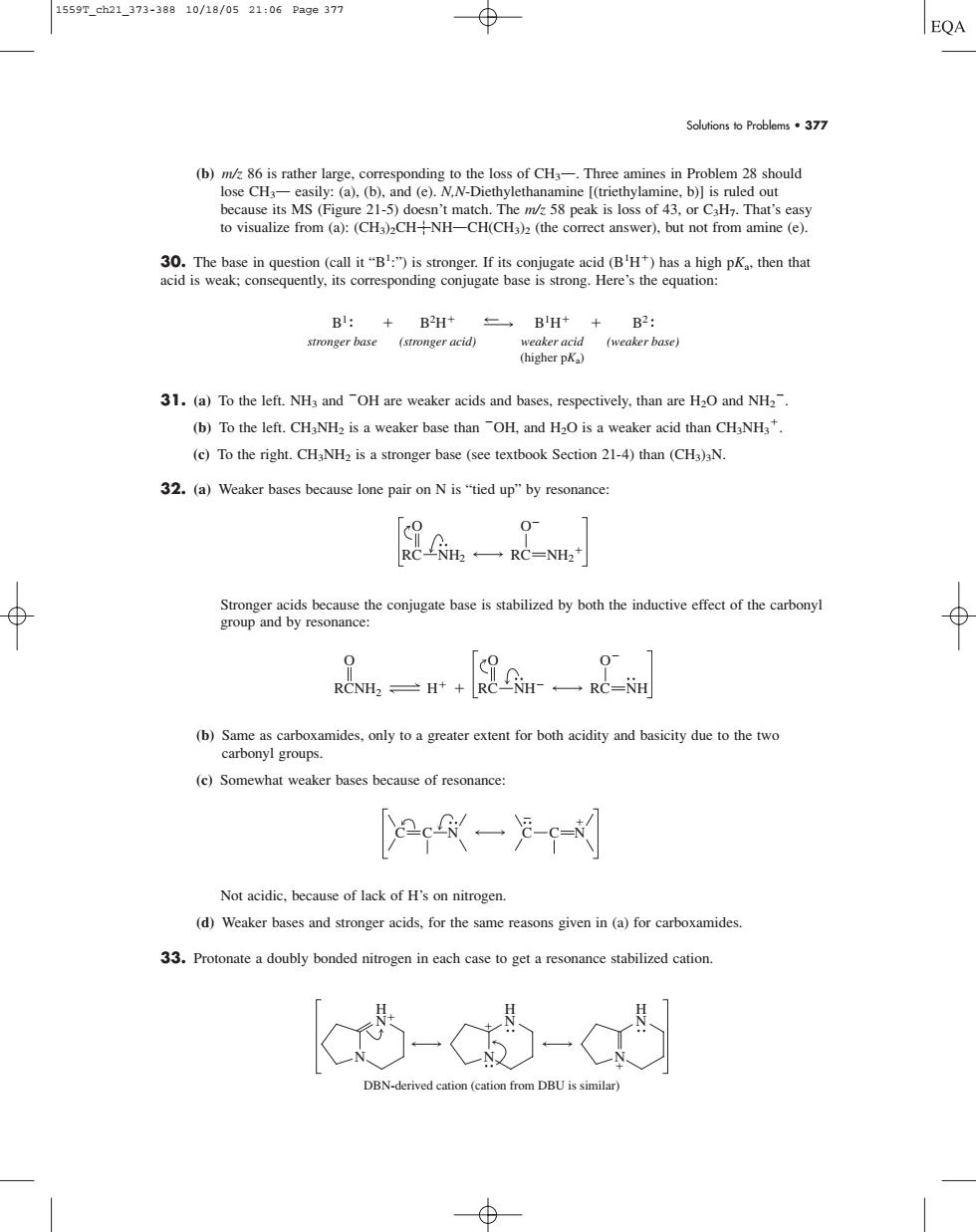正在加载图片...

1559T_ch21_373-38810/18/0521:06Pa9e377 ⊕ EQA Solutions to Problems.377 the loss s in Problet because its MS (Figure 21-5)docsn't match.Them58 peak is loss of 43.or C.That's casy to visualize from(a):(CH3)2CH--NF CH(CH3)2 (the correct answer),but not from amine (e). 30.The base in question(call it"B")is stronger.If its conjugate acid (BH)has a high pKthen that acid is weak;consequently,its corresponding conjugate base is strong.Here's the equation B +B*一BH*+B songer base (stronger acid 31.(a)To the left.NHs andOH are weaker acids and bases.respectively,than are H2O and NH2- (b)To the left.CHaNH2 is a weaker base thanOH,and H2O is a weaker acid than CHaNH3' (e)To the right.CHaNH2 is a stronger base (see textbook Section 21-4)than (CHa)N. 32.(a)Weaker bases because lone pair onN is"tied up"by resonance 0°1 0 0-1 (b)Same as carboxamides,only to a greater extent for both acidity and basicity due to the two carbonyl groups. (c)Somewhat weaker bases because of resonance 一- Not acidic,because of lack of H'sn nitrogen. (d)Weaker bases and stronger acids,for the same reasons given in (a)for carboxamides 33.Protonatea doubly bonded nitrogen stabilized cation a-ah-a DBN-derived(ti rm Solutions to Problems • 377 (b) m/z 86 is rather large, corresponding to the loss of CH3O. Three amines in Problem 28 should lose CH3O easily: (a), (b), and (e). N,N-Diethylethanamine [(triethylamine, b)] is ruled out because its MS (Figure 21-5) doesn’t match. The m/z 58 peak is loss of 43, or C3H7. That’s easy to visualize from (a): (CH3)2CHO† NHOCH(CH3)2 (the correct answer), but not from amine (e). 30. The base in question (call it “B1 :”) is stronger. If its conjugate acid (B1 H) has a high pKa, then that acid is weak; consequently, its corresponding conjugate base is strong. Here’s the equation: 31. (a) To the left. NH3 and OH are weaker acids and bases, respectively, than are H2O and NH2 . (b) To the left. CH3NH2 is a weaker base than OH, and H2O is a weaker acid than CH3NH3 . (c) To the right. CH3NH2 is a stronger base (see textbook Section 21-4) than (CH3)3N. 32. (a) Weaker bases because lone pair on N is “tied up” by resonance: Stronger acids because the conjugate base is stabilized by both the inductive effect of the carbonyl group and by resonance: (b) Same as carboxamides, only to a greater extent for both acidity and basicity due to the two carbonyl groups. (c) Somewhat weaker bases because of resonance: Not acidic, because of lack of H’s on nitrogen. (d) Weaker bases and stronger acids, for the same reasons given in (a) for carboxamides. 33. Protonate a doubly bonded nitrogen in each case to get a resonance stabilized cation. N NH N N H N DBN-derived cation (cation from DBU is similar) N H CCN CCN RC O RCNH2 O H RC NH O NH RC O NH2 RC O NH2 B1 B2 H stronger base B2 (stronger acid) (weaker base) B1 H weaker acid (higher pKa) 1559T_ch21_373-388 10/18/05 21:06 Page 377�������